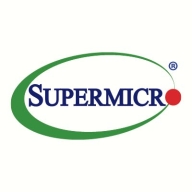

The PowerEdge C and Supermicro SuperBlade are competing products in the server market, each offering distinct advantages. Despite the PowerEdge C's pricing and support, Supermicro SuperBlade often has the upper hand due to its advanced features and perceived long-term value.
Features: PowerEdge C provides high processing power and flexibility, making it ideal for diverse workloads. It supports various customization options, ensuring adaptability to different enterprise needs. Integrated remote management tools like iDRAC enhance its usability for administrators. Supermicro SuperBlade, on the other hand, features an advanced integrated architecture, offering superior energy efficiency. It consolidates multiple functionalities into a seamless system, optimizing space and power usage, which is beneficial for enterprises focusing on compact and efficient setups. Its engineering allows for robust resource utilization and cost savings over time.
Room for Improvement: PowerEdge C could benefit from enhanced energy efficiency measures to reduce operational costs further. Improving the integration of its components into a more cohesive system could provide additional advantages in terms of space and resource management. Furthermore, enhancing its initial setup to match market demands could elevate user experience. Supermicro SuperBlade might improve by simplifying the deployment process for less technically inclined users, increasing its component flexibility to suit a wider range of applications, and optimizing its cost structure to appeal to cost-sensitive markets.
Ease of Deployment and Customer Service: PowerEdge C offers a straightforward deployment process supported by comprehensive technical assistance, ensuring smooth implementation. Supermicro SuperBlade, while having a more complex deployment structure, is offset by its robust customer support, which effectively addresses intricate issues. The ease of setting up PowerEdge C contrasts with SuperBlade’s more engineered setup that may lead to better performance and scalability benefits over time.
Pricing and ROI: PowerEdge C is characterized by competitive pricing, with lower upfront costs leading to a quicker return on investment. Supermicro SuperBlade, despite requiring a higher initial expenditure, offers potential long-term savings through energy efficiency and operational efficiencies, presenting an attractive ROI. The choice between the two depends on whether immediate affordability or long-term strategic value aligns better with business needs.


PowerEdge C help you to maximize hyperscale performance with up to 4 independent server nodes, flexible storage and shared infrastructure in a compact 2U chassis.
Supermicro SuperBlade delivers innovative computing performance and efficiency, perfect for data-intensive tasks. With its modular design, it optimizes space and power, providing a flexible and scalable infrastructure for demanding business workloads.
Supermicro SuperBlade is specifically engineered for modern data centers needing high-density computing. It offers a compact, modular architecture that simplifies system management and enhances agility. It integrates seamlessly with cloud and virtualization technologies, supporting diverse applications and workloads. Its design focuses on reducing operational costs while achieving peak performance. Users appreciate its balance of power efficiency and high computing capacity.
What are the key features of Supermicro SuperBlade?Supermicro SuperBlade is widely implemented in sectors such as finance, healthcare, and research where high computational power and storage are critical. In finance, it's used for real-time analytics and transactions. Healthcare facilities use it for patient data analysis and complex simulations, while research institutions leverage SuperBlade for simulations and data-intensive research tasks. Its adaptability allows enterprises to efficiently meet technical requirements unique to each industry.
We monitor all Blade Servers reviews to prevent fraudulent reviews and keep review quality high. We do not post reviews by company employees or direct competitors. We validate each review for authenticity via cross-reference with LinkedIn, and personal follow-up with the reviewer when necessary.